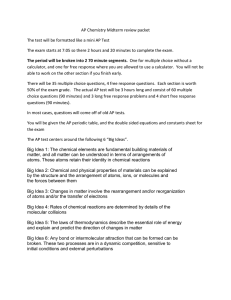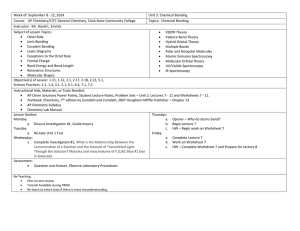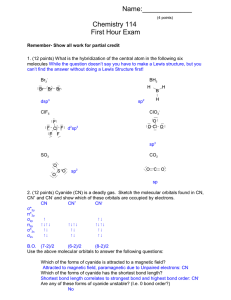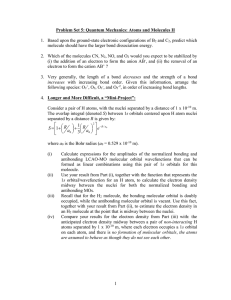Organic Molecules ~ Structure and Nomenclature ~
advertisement
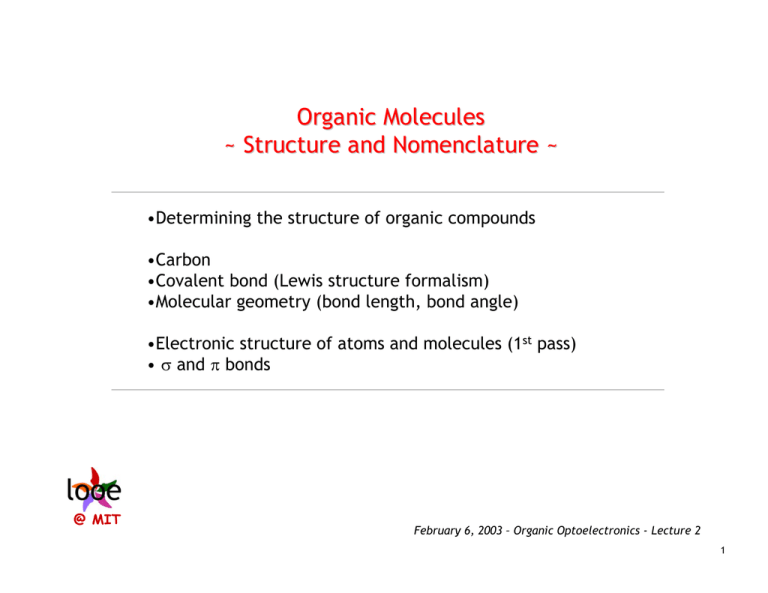
Organic Molecules ~ Structure and Nomenclature ~ •Determining the structure of organic compounds •Carbon •Covalent bond (Lewis structure formalism) •Molecular geometry (bond length, bond angle) •Electronic structure of atoms and molecules (1st pass) • σ and π bonds @ MIT February 6, 2003 – Organic Optoelectronics - Lecture 2 1 Organic Field Effect Transistors pentacene Charge carrier mobility is dependent on molecular order within the semiconducting thin film -VD source drain + + insulator + + semiconductor gate substrate -V G Addition Current modulation is achieved by electric field-induced charge build-up at the interface between the organic semiconductor and the insulator IMPROVED MOLECULAR ORDERING Larger grain sizes Lower defect densities Enhanced mobility Dimitrakopoulos, et. al., IBM J. Res. and Devel. 45, 11 (2001). 2 M.A. Baldo, priv. comm. PENTACENE 3 MOLECULE – derived form “molecula” - meaning small mass (a smallest unit of chemical compound that still exhibits all its properties) HOMONUCLEAR diatomic molecules H2 Cl2 HETERONUCLEAR HCl Adapted from Molecular Physics and Elements of Quantum Chemistry by H. Haken and H.C. Wolf 4 Potential Energy as a Function of Internuclear Distance, R Adapted from Molecular Physics and Elements of Quantum Chemistry by H. Haken and H.C. Wolf 5 The Size of the System Photosynthetic Process The reaction center for bacterial photosynthesis as a molecular functional unit. The schematic drawing shows the photoactive molecules, which are embedded in a larger protein unit. The latter in turn is embedded in a cell membrane. Light absorption by the central chlorophyll dimer is the first step in the charge separation which sets off the chemical process of photosynthesis. The picture is based on the x-ray structure by Deisenhofer, Huber, and Michel (Nobel Prize 1988), is taken from the newspaper “Die Zeit” Adapted from Figure 1.3 caption of Molecular Physics and Elements of Quantum Chemistry by H. Haken and H.C. Wolf water, amonia, benzene our AREA of INTEREST chlorophyll crown ethers DNA log (SIZE) 6 Seeing the shape of molecules with Transmission Electron Microscope (TEM) An electron microscope image of hexadecachloro copper phthalocyanine molecules. The molecules form a thin, oriented layer which serves as substrate. The image was made with a high-resolution 500kV transmission electron microscope and was processed using special imageenhancement methods. The central copper atoms and the 16 peripheral chlorine atoms may be most clearly recognized. (This picture was kindly provided by Prof. N. Uyeda of Kyoto University.) Figure 1.4 caption from Molecular Physics and Elements of Quantum Chemistry by H. Haken and H.C. Wolf 7 Seeing the shape of molecules with Scanning Tunneling Microscope (STM) or Atomic Force Microscope (AFM) STM scan of ordered PTCDA monolayer on HOPG molecular orbital calculation of the electron density in the highest occupied molecular orbital of a PTCDA molecule Agreement between the calculation and the experiment exemplifies maturity of detailed understanding of electronic arrangement on molecules. However, … DYNAMIC ELECTRONIC PROCESSES in MOLECULES and MOLECULAR ASSEMBLIES are NOT WELL UNDERSTOOD and present a topic of our research 8 Seeing the shape of molecules with electron diffraction Radial distribution functions D describing the electron density as a function of the bond length R between atomic nuclei in the molecules PH(CH3)2 and PH2CH3, obtained from electron diffraction patterns. The maxima in the distribution functions can be correlated with the inter-nuclear distances indicated. [After Bartell, J. Chem. Physics. 32, 832 (1960)] Quoted from Figure 2.1 of Molecular Physics and Elements of Quantum Chemistry by H. Haken and H.C. Wolf 9 Seeing the shape of molecules with x-ray diffraction An simulated electron density diagram of the porphyrine molecule. The H atoms are not visible, since they are poorly detected by X-ray diffraction methods compared to atoms with higher electron densities, such as nitrogen. The contour lines represent the electron density. Their interval corresponds to a density difference of one electron per Å2, and the dashed lines represent an absolute density of 1 electron per Å2. Quoted from Figure 2.1 of Molecular Physics and Elements of Quantum Chemistry by H. Haken and H.C. Wolf 10 Mass Spectroscopy 100 m/e = 16 80 Relative abundance Relative m/e Abundance 1 3.36 12 2.80 13 8.09 14 16.10 15 85.90 16 100.00 17 1.11 60 40 20 0 0 methane 10 m/e 20 Image of a mass spectrometer showing its internal organs. Adapted from Organic Chemistry by G.M. Loudon 11 TETRAHEDRAL methane TRIGONAL LINEAR acetylene Adaped from Organic Chemistry by G.M. Loudon 12 ENERGY 3d ___ ___ ___ ___ ___ 3p ___ ___ ___ 3s ___ 2p ___ ___ ___ 2s ___ 1s ___ Schematic representation of the relative energies of different orbitals in a manyelectron atom. The exact scale varies from atom to atom, but the energy levels tend to be closer together as the principle quantum number increases. Quoted from Figure 2.6 in Organic Chemistry by G.M. Loudon 13 z Atomic Orbitals y x s dz2 Py Pz d xy d zx Px d x 2 −y 2 d yz Atoms that constitute typical organic compounds such as H, C, N, O, F, P, S, Cl have outermost (valence) electrons in s and p orbitals. When molecules are formed the s and p atomic orbitals form σ and π 14 From NASA website In 0 A.D. 9 elements were known (C, S, Fe, Cu, Ag, Sn, Au, Hg, and Pb) 15 subtract 1s orbitals ENERGY (1s-1s) node Antibonding Molecular Orbital energy of isolated hydrogen atoms isolated hydrogen atoms add 1s orbitals (1s+1s) Addition Bonding Molecular Orbital Subtraction Adapted from Organic Chemistry by G.M. Loudon 16 Hybrid Orbitals bonding in METHANE 2p ENERGY 2s 1s ___ ___ ___ ___ ___ } Mix 2s and 2p orbitals 2(sp3) ___ ___ ___ ___ 1s ___ carbon in methane carbon itself Organic Chemistry by G.M. Loudon 17 Hybrid Orbitals bonding in AMMONIA ENERGY 2p ___ ___ ___ 2s ___ 1s } Mix 2s and 2p orbitals ___ 1s ___ Nitrogen in ammonia Nitrogen itself N 2(sp3) ___ ___ ___ ___ Lewis Structure Orbital Picture H H H Adapted from Organic Chemistry by G.M. Loudon 18 H H H CC H H H H H H C C H H H C C Bonding molecular orbitals in ETHANE sp3-sp3 σ-bond sp3-1s σ-bond Adapted from Organic Chemistry by G.M. Loudon 19 Alkenes, or olefins, are hydrocarbons that contain carbon-carbon double bonds. Ethylene and propylene are the two simplest alkenes. 3 C C ethylene Structures of ethylene, ethane, propylene, and propane A DOUBLE BOND 3 3 2 Adapted from Organic Chemistry by G.M. Loudon 20 Orbitals of a sp3-hybridized carbon 2p ___ ___ ___ ___ 1s ___ ENERGY 2s } Mix 2s and 2p orbitals 1s (a) The general shape of an sp2 hybrid orbital is very similar to that of an sp3 hybrid orbital, with a large and small lobe of electrons density separated by a node. (b) Spatial distribution of orbital son an sp3hybridized carbon atom. Quoted from Figure 4.3 of Organic Chemistry by G.M. Loudon 2(sp3) ___ ___ ___ ___ ___ sp2 orbital sp2 orbitals (a) p orbital (b) 21 Bonding molecular orbitals in ETHYLENE The p-bonds in ethylene p orbital ENERGY Overlap of p orbital to form boding and antibonding π-molecular orbitals. The π-bond is formed when two electrons occupy the bonding π-molecular orbital. antibonding p2 – p1 __ __ bonding wave peak wave trough Quoted from Figure 4.5 of Organic Chemistry by G.M. Loudon 22 Bond Length The following generalizations can be made about bond length: 1. Bond lengths between atoms of a given type decrease with the amount of multiple bonding. Thus, bond lengths for carbon-carbon bonds are in the _ order C-C > C =C > C=C 2. Bond lengths tend to increase with the size of the bonded atoms. This effect is most dramatic as we proceed down the periodic table. Thus, a CH bond is shorter then a C-F bond, which is shorter then a C-Cl bond. Since bond length is the distance between the center of bonded atoms, it is reasonable that larger atoms should form longer bonds. 3. When we make comparisons within a given row of the periodic table, bonds of a certain type (single, double, or triple) between a given atom and a series of other atoms become shorter with increasing electro negativity. Thus, the C-F bond in H3C-F is shorter then the C-C bond in H3C-CH3. This effect occurs because a more electronegative atoms has a greater attraction for the electrons of the bonding partner, and therefore ‘pulls it closer,’ than a less electronegative atom. Quoted from Organic Chemistry by G.M. Loudon 23 Bonding in Aliphatic Hydrocarbons double bonds (alkenes) single bonds (alkanes) C-H σ−bonds sp2 orbital sp2 orbitals p orbital p orbital sp3-1s σ-bond π-molecular bonding orbital sp3-sp3 σ-bond Adapted from Organic Chemistry by G.M. Loudon 24


